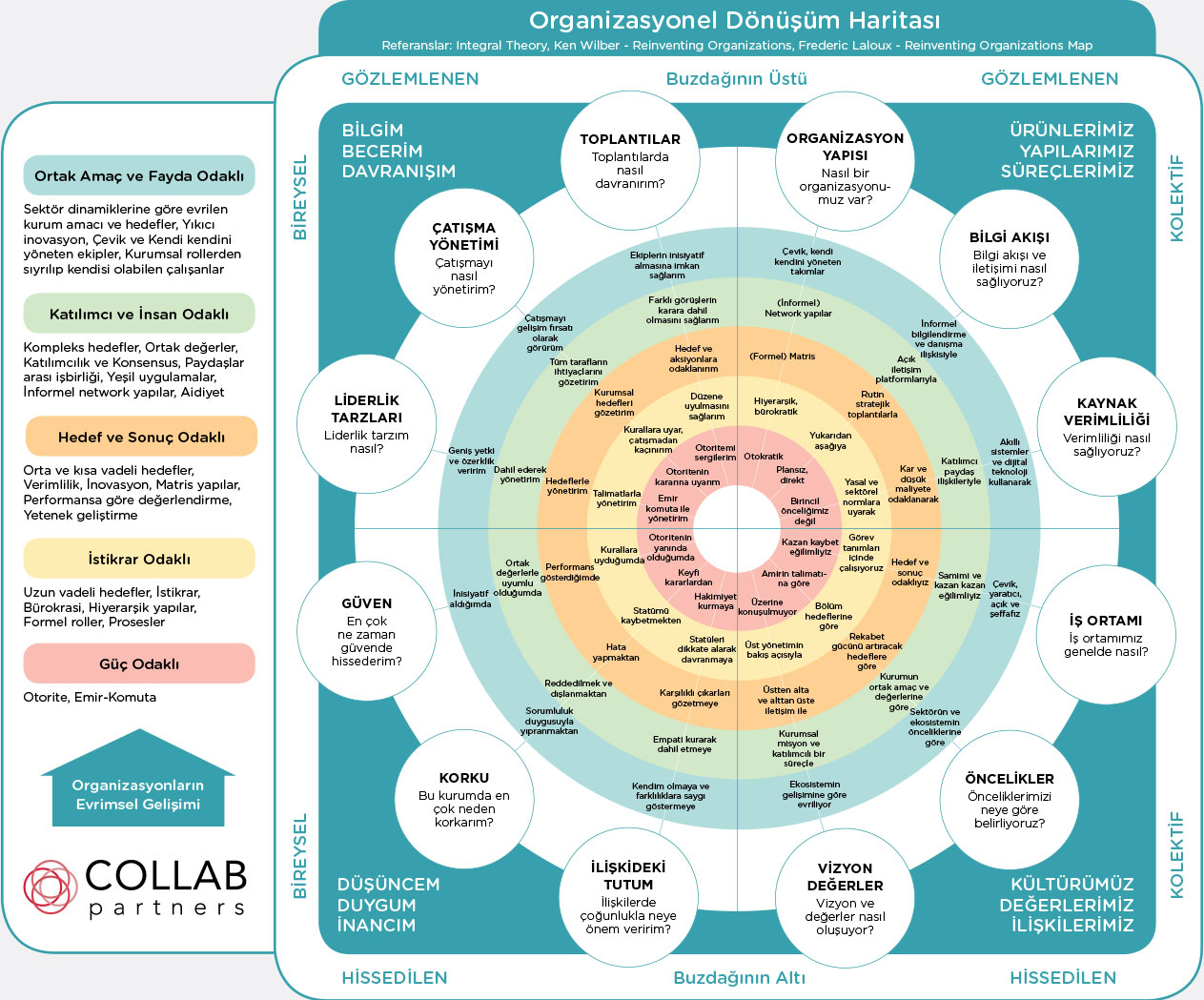
Future of Work
The current pace of disruptive technologies is unprecedented in history. Global dynamics render uncertainty as the “New normal.” While these megatrends radically change our lives, the way we work and manage continues to be based on the old mindsets and structures. It seems inevitable that organizational structures that focus on power, stability, or performance evolve into agile forms capable of adapting to change. This fact obliges every organization to work on cultural and structural transformation and almost every manager to lead the change.
Holistic Approach
In change initiatives, organizations can frequently focus on the tip of the iceberg. Nevertheless, all the structures, processes, and behaviors we observe here are an extension of deep collective beliefs, stereotyped habits, values, and emotions. Therefore, initiatives that do not focus on the entire iceberg are struggling to cope with potential resistances, use corporate energy efficiency, and ensure sustainability. We perceive our role to facilitate change as a mission that overcomes resistances, increases adaptation, efficiency, and speed. We care about the fact that each organization has its unique ecosystem and DNA. We design our programs with an agile and flexible approach that focuses on your needs in line with this holistic view.
ORSC System Coaching (Organization & Relationship Systems Coaching)
- In ORSC Systems Coaching developed by CRR Global, organizations are viewed as relationship systems.
- The purpose is not to repair the system but to mirror the system. When a system’s perception of itself changes, its identity changes as well.
- Systems Coaching offers efficient tools to facilitate change in an inclusive way.
- The members of the system are responsible for change and transformation.


Appreciative Inquiry
- It was developed by Case Western Reserve University faculty member David Cooperrider.
- It encourages creating a climate of appreciation and meaning in organizations to ensure high performance and success. It is based on positive psychology and social structural theories.
- It reveals the strengths, shared passions, and enthusiasm of the organization. It makes common vision and future plans.
- It manages change management in a 5-step model: At the stages of “Define,” “Discovery,” and “Dream,” the right brain is essentially activated to encourage the common mind, passion, intuition, and experimental spirit. During the “Design” and “Destiny” stages, structures, and systems are developed to bring the shared vision to life by activating the left brain.
Theory U
- It was developed by MIT Sloan School of Management faculty members Otto Scharmer and Peter Senge. It is popularized by the Presencing Institute.
- The theory argues that to solve the system problems of the 21st century, every individual should live with an awareness based on inner insights in the workplace, family, and society.
- It invites individuals to explore their “blind spots” based on their assumptions and memorizations about the ecosystem they live in to reach their leadership potential. Nevertheless, it points out the importance of Collective Leadership for the transition of society from “ego to ecosystem.”
- It proposes methods involving individual and interdisciplinary teamwork to create “learning institutions.”


Art of Hosting
- The Art of Hosting approach focuses on finding new solutions to today’s business world’s increasing challenges, enabling common sense. It perceives institutions as “living systems,” not mechanical or inanimate, and consequently invites organizations that want to generate new solutions and innovate to act as a part of nature.
- All innovations in nature take place at the edge of chaos or in what we call “chaordic” between chaos and order.
- It invites everyone to explore different perspectives, listen, discover the intentions and needs behind the ideas with a sense of curiosity even if the ideas conflict, and take the initiative with conscious choices to reveal the organization’s potential and a common mind.
Design Thinking
- The “Design Thinking” approach was developed by Stanford school.
- This approach starts with the basic principle that every experience can be designed. To achieve this, practices that will provide valuable insights are applied before determining the problems and needs. Then, the first ideas are generated with quick feedback processes.
- Without waiting for the idea to become perfect, a prototype product is developed at a low cost by rapid modeling.
- The Design Thinking method is used not only in product design but also in designing business processes. It considers an interdisciplinary ecosystem to work together to create valuable insights.


Co-Active Leadership
- In Co-Active Leadership developed by the CTI (Coaches Training Institute), the leader is the person who connects with his/her own values and environment needs and acts with the urge to create a difference. The impact that s/he creates nurtures new environments to develop leadership.
- S/he argues that every individual has leadership potential, and that people can create value in every environment based on their inner awareness and impulses.
Co-Active Coaching
It was developed by the CTI (Coaches Training Institute).
Co-Active Coaching considers that people are naturally creative and have the answers they seek.
Co-Active Coaching helps a person discover his/her values to improve the quality of work and private life. In parallel with this, the persons realize the inner barriers that manifest themselves in mentality and behavioral patterns. It supports individuals in guiding their lives and being the best they can be with decisions and actions based on the values the people discover.

